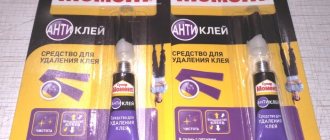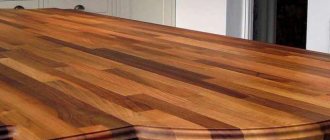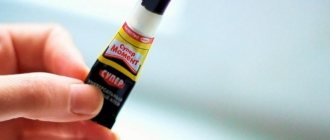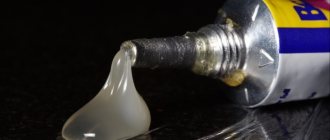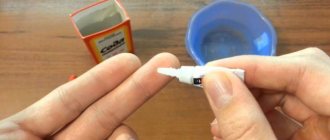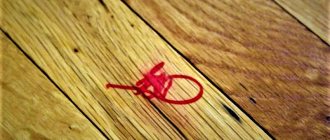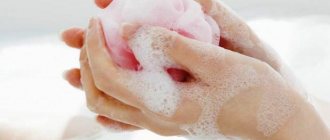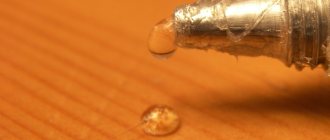Methods for cleaning concrete surfaces from adhesives
If, after dismantling the old tiles, there are tile adhesive residues on the concrete floor or wall, they must be removed. It is quite difficult to completely remove hardened glue. This can be done in several ways, which, depending on the effect, are divided into mechanical and chemical.
Mechanical methods
With the mechanical method, force is used using various tools. For example, in order to remove a layer of old glue from a wall, use a chisel and a hammer. This method requires a lot of effort and time, but is only suitable for removing cement-based adhesive .
Epoxy glue cannot be removed with a chisel.
The method for removing tile adhesive with a chisel is as follows:
- the pointed edge of the chisel must be placed against the border of the glue and the wall;
- the chisel is evenly moved forward, delivering gentle but frequent blows to its blunt end. As a result of such actions, the solution will break off from the surface. The process is continued until the entire surface is completely cleaned. At the same time, it is periodically watered with water to reduce the amount of dust in the air;
- small adhesive residues should be moistened with a special solvent for concrete, and then the deposits should be removed with a stiff brush;
- Rinse the cleaned surface thoroughly with water.
A less labor-intensive process is to use a grinder with an abrasive disc or diamond crown. But here you need experience and accuracy, since this procedure is not the direct purpose of the tool. It does not have a dust collector or the ability to connect to a construction vacuum cleaner. When using an angle grinder, the glue must be removed in small layers, periodically sprinkling the surface with water . Traces of adhesive remaining on the concrete base should be cleaned with coarse sandpaper.
The techniques described above are applicable for cleaning small areas.
For larger-scale work, special professional methods will be needed, among which the most popular are:
- grinding;
- abrasive blasting;
- waterjet processing.
Grinding
The most common way to remove various contaminants from concrete surfaces is grinding. To clean in this way, special grinding machines are used. When choosing the right equipment, be sure to take the surface area into account.
There are the following types of grinding machines:
- household . They are equipped with one circle and can be used for a limited time. The power of such machines, as a rule, does not exceed 3 kW. They do not have special devices that provide water supply and dust collection. Due to their light weight, they are quite easy to work with, but they are not suitable for processing large areas;
- professional _ Such machines have a more thoughtful design and are used to process large areas. Most models are equipped with three abrasive discs operating on the planetary gear principle, that is, they rotate around the central axis of the machine and around their own axis. As a rule, they provide the ability to regulate the grinding speed, as well as a water supply and dust collection system;
- edging _ They are very compact and have a special protective ring that prevents the grinding tool from coming into contact with an external barrier.
Edge grinders are used to process areas close to columns and walls
An abrasive tool does an excellent job of not only removing contaminants, but also preparing the concrete surface for applying a protective or decorative coating. Recently, diamond tools have been widely used. The basis of a diamond tool is a metal body on which cutting segments coated with diamond are specially attached.
Diamonds have higher strength and efficiency compared to conventional abrasives. Using a diamond tool, you can process a surface in record time, reducing time costs by at least ten times.
Abrasive blasting
Treating concrete surfaces with abrasives has proven to be one of the most effective cleaning methods. With this method, abrasive particles are accelerated at the exit from a special abrasive blasting device due to the energy of compressed air.
A powerful flow of air and abrasive provides excellent cleaning of the concrete surface and a grinding effect. A variety of materials are used as abrasives: sand, corundum, metal shot, slag, glass beads, ceramic beads, fruit seed crumbs, etc.
During abrasive blasting, contaminants are removed from the surface and surface hardening of the concrete occurs . The surface becomes well prepared for the application of various coatings. Since most abrasive materials consist of angular particles, the concrete surface after cleaning acquires the necessary roughness (a surface profile is formed).
Many manufacturers of protective and paintwork materials indicate what size the surface profile should be to ensure high-quality adhesion and reliable operation of the finished coating.
Waterjet machining
The peculiarity of this treatment is that, along with the abrasive material, water is also used, which helps wash away the cleaned particles and prevents the formation of dust. The use of water significantly increases the cleaning speed. This method allows you to efficiently, quickly and safely remove contaminants from a concrete surface of any configuration. Waterjet cleaning does not change the mechanical properties or structure of the concrete surface, but only carefully removes dirt and damaged concrete layers.
The effectiveness of such cleaning depends on the speed at which the water jet hits the surface being cleaned, as well as on the amount of water flowing out per unit time. By changing the water flow and its pressure, as well as the ratio of water and abrasive components, you can adjust the degree of cleaning depending on the type of tile adhesive present on the surface being cleaned.
Chemical method
To implement this method, numerous chemicals are used, for example, AtlasSzop, Keranet or Sopro ZEA 703. Each of them usually lists all stages of the cleaning process on the label.
The chemicals contain special active substances that quickly remove dried old glue
In addition, before purchasing a chemical composition for removing tile adhesive, you should carefully study the labeling, since not all of them are universal . In such compositions, the components may be different, so some of them soften the glue, while others dissolve.
The effectiveness of work on removing tile adhesive from concrete surfaces is significantly increased by combining chemical and mechanical methods. In this case, sequentially use:
- softening old glue. At this stage, the layer of hardened glue is generously moistened with warm water. In this case, acids and solvents are also used, depending on the composition of the adhesive mixture used;
- mechanical cleaning. After impregnation of the adhesive mass with appropriate solutions, they begin to remove it. To do this, use hard brushes, sandpaper or a grinding tool;
- If the contaminants cannot be removed at one time, repeat sequential treatment;
- at the last stage, the surface is washed with clean water.
When chemical cleaning, special attention should be paid to the following issues:
- whether the selected solvent is suitable for removing a particular adhesive mixture;
- Is the chosen product too aggressive for concrete?
With this type of treatment, it is necessary to use only proven chemical compounds with a certain concentration and in a certain quantity, since there is a risk of removing not only contaminants from the concrete, but also causing harm to the cement stone.
A properly treated concrete surface, in addition to cleaning, also acquires the necessary degree of adhesion to impregnations , primers and other materials that increase its service life.
Professional products
Special solutions are professional methods for removing glue. Sold in hardware or construction stores. Usually they write “anti-glue”. It is necessary to moisten a sponge in the product and apply it to problem areas. The solution removes stains in about 15-20 minutes. Remove any residue with a dry cloth and repeat the process if necessary.
You might be interested in reading the article “How to remove super glue quickly: which methods are not recommended.” Read here...
Methods for removing mouse adhesive from carpets and floors
Attempts to wash such a mixture if it gets on furniture or fabric are very difficult in practice. For this purpose, dishwashing liquid and oil are used. Although this method does not work 100%, since there is a risk of damage to the material. To remove mouse glue stains from the carpet, wash them with kerosene, after doing a test on an inconspicuous area.
Since the risk of spoiling the item is increased, it is best to seek help from a dry cleaner. Its employees have all the tools and skills needed to professionally remove glue from furniture and clothing.
It is easier to wash the glue off the floor:
- Moisten a clean rag with alcohol and gently wipe off the substance.
- Treat the contaminated area with a solution of lemon juice and water.
- Dilute laundry soap in 1 liter of water.
- If all efforts are unsuccessful, then you can use a spatula. Excess adhesive is removed with a hard sponge soaked in alcohol.
Wooden floors can be cleaned with solvent. But if there is paint on it, then there is a risk of defects. Because of this, it is removed from painted surfaces (including plastic) using vegetable oil. The greasy film is washed off with gentle movements with a soap solution.
Methods for removing assembly adhesive
There are two main options for cleaning the surface from hardened adhesive solution:
- Wet. The contaminated area is moistened with a special product using a brush or sponge. After the glue softens a little, it remains to be removed with a damp cloth.
- Dry. The frozen material is removed with a scraper, spatula, hammer or chisel. The remains of the building composition are cleaned with a cord brush or sandpaper. This method must be used to remove dirt very carefully so as not to damage the surface!
When removing old glue, chemical agents have proven themselves to be excellent. It is better to use acid-containing substances, because... they dissolve frozen building mixtures and significantly speed up the solution of the problem. Before you start cleaning, you need to make sure that the product will not damage the surface. To do this, try applying the product to an inconspicuous area.
When working with concentrated chemicals, be sure to wear rubber gloves and a respirator, and ventilate the room.
The BAGI line for cleaning after renovation includes a special product - Cementin. This is a concentrated product for final cleaning of surfaces after repair. It dissolves not only assembly adhesive, but also dried building mixtures, tile adhesive, durable paints, joint filler, cement, lime and rust.
Cementin is suitable for processing facades, interiors, tools, and equipment. It can be used to clean a wide variety of surfaces:
- glass
- porcelain
- brickwork
- ceramic tile
- faience
- natural stone, excluding marble
Before use, try the product on an inconspicuous area. Cementin is suitable for all acid-resistant surfaces.
Preparatory work
During their implementation, a fairly large amount of dirt is formed, so in order to avoid contamination of the floor covering and other surfaces of the room with an existing finish, you need to take care of its protection in advance. Otherwise, it can become seriously dirty, and sometimes even be completely damaged, becoming covered in stains and more, losing its attractive appearance.
First, you need to protect all sockets, switches and ventilation holes with masking tape. Next, along the walls where the wallpaper glue will be removed, you need to spread a tarpaulin, thick plastic film or something similar on the floor. Further, if there is furniture in the room, then it is also advisable to take it out or, if this is not possible, move it to the center of the room. To avoid contamination, it also needs to be protected with plastic film and masking tape. Finally, you need to turn off the electricity in the room, which will eliminate the associated failures that are otherwise possible.
How to remove glue from a plastic label
Plastic products, such as children's dishes, sand utensils, flower pots and many other products, are most often “decorated” with sticky labels. You can remove stickers and adhesive stains from a plastic surface using the following methods.
Mechanical cleaning by hand
If the sticker was applied relatively recently, remove the adhesive layer with your hands. To do this, remove the paper part and the remaining sticky layer with three fingers, rolling it up. We remove the formed pellets, and wash off the remaining glue with a sponge soaked in dish soap. The method is effective if the label peels off the product without any problems.
Instructions for removing assembly adhesive
To remove construction adhesive, follow these steps:
- Prepare the surface, clean it from dirt and dust.
- Prepare a solution of Cementin with warm water in a ratio of 1:5 (1 part Cementin to 5 parts water), for very heavy stains 1:3.
- Apply the solution evenly to the contaminated area, scrub lightly with a soft brush and leave to act for 5 minutes.
- Remove any remaining adhesive with a sponge or rubber spatula.
- Rinse the area thoroughly with clean water.
Tools for removing adhesive
For delicate processing of ceramic tiles, especially thin tiles, special devices are used. The adhesive mixture must be removed from the inside carefully, slowly, without excessive effort.
You can remove tile adhesive using the following means:
- A block with coarse sandpaper nailed down. Used to separate old substances after soaking.
- Construction float – used for a thick layer of cement mixture.
- The grinder is a powerful tool that requires good skills.
| Block with sandpaper | Construction float | Bulgarian |
You can scrub off the glue with force only if it is not a fragile tile. To minimize the risk of splitting, you need to place the part on a flat surface.
Removing not completely dried glue
When, after installation work, drops of adhesive remain on the tiles, this dirt must be removed step by step. Step-by-step instructions on how to remove tile adhesive from a wall:
- Treat the area where the solution got in with a float. To avoid damaging seams that have only recently been filled, the tool should be held vertically to the tile. Movements should be carried out diagonally. Don't do everything too abruptly or put in a lot of effort.
- When it becomes difficult to wipe off a solution that has not completely dried, it can be moistened with water. This way the composition will respond more quickly to the influence of the tool.
- After the adhesive has completely dried, it should be washed off with a sponge soaked in warm water.
Reasons for the need to remove glue
Before painting surfaces or gluing them with new canvases after previously removing old ones, you should get rid of the layer of adhesive composition that was used for fixation in advance. Initially, the reason is that because of it or the left paint coating, which over time loses its own positive properties, a film is formed that acts as a barrier that reduces the level of adhesion of new wallpaper to the base.
The same factor can lead to the paintings quickly peeling off from the walls and repeated repair work, which means you will have to spend an hour again, and most likely more than one, as well as additional funds for the purchase of glue and related materials. Moreover, such a need can arise repeatedly and in the future after a certain period of time, since peeling off the wallpaper will occur in different places with varying frequency.
How to remove dried super glue stains
How to remove glue from linoleum if the adhesive residue has dried? There are some effective tips.
- You will need an iron and natural fabric folded in several layers. Cover the glue spots with a cloth and place a heated iron on top. After some time, the glue will begin to melt and be absorbed into the fabric.
- How to effectively remove instant glue from linoleum using improvised means? You will need cold water, a regular hair dryer and a spatula. We treat the area with water or a hairdryer in cold mode and remove the residue with a spatula.
- The method is identical to the second method, only we turn on the hair dryer at high temperature. We bring it to the problem area and wait for the glue to heat up. Remove the residue with a damp cloth.
conclusions
A concrete surface is considered clean if there are no foreign substances present on it that could reduce the adhesion strength of concrete to any coating. Cleaning can be done chemically or mechanically. Mechanical cleaning is quite labor-intensive and requires the use of special equipment or a large number of human resources . When using a chemical method, difficulties often arise associated with controlling the depth of the split layer. Very often, chemical cleaning is carried out in combination with mechanical cleaning, which significantly speeds up and facilitates the process.
The abrasive blasting method significantly increases the productivity of cleaning work, but its use generates a large amount of dust and secondary waste, which is not always acceptable from the point of view of labor safety. In terms of economic costs, waterjet cleaning is the most effective . This technology is also environmentally friendly. The use of water allows you to increase the efficiency and speed of cleaning by 1.5-2 times compared to the dry method.
Techniques for mechanically cleaning concrete from tile adhesive are discussed in the video:
Folk remedies
How to remove super glue from linoleum if you don’t have time to run to the pharmacy or hardware store?
- Vinegar is an excellent folk remedy for removing stains without consequences. Prepare the solution: 1 tbsp. Dissolve vinegar in a glass of water. Wash with a cloth.
- How to remove super glue from linoleum with a handy product? Take vegetable oil. Generously wet the cloth, cover the stains with glue for a moment, wait ten minutes. Remove with a damp cloth.
- How to remove glue from linoleum without leaving traces? Laundry soap will help. To remove stains, you will need a bar of soap dissolved in hot water and a rag. Wet it in a soapy solution and remove the problem areas.
Attention! It is unacceptable to wash all linoleum with hot water.
Mechanical method
How to remove super glue from linoleum mechanically without consequences? It is necessary to carefully scrape or tear off the dried areas. To cause less damage to the coating, the mechanical method is combined with others. Choose tools that can minimally damage the linoleum: spatula, needle, silicone spatula.
If you use a purely mechanical method, the principle is as follows:
- tap gently on the stains (ensure that the problem areas crack);
- scrape off the remains with a needle.
Cleaning tile joints
To tightly connect the elements, they are fastened with a solution. There are many ways to remove glue from seams.
It is most effective to use a special knife or drill with a round attachment for stripping (metal brush). The second method allows you to do the job carefully and not scratch the tiles.
In some cases, the thickness of the frozen mass, after removing the tiles, does not greatly interfere with the work process. In such situations, it is enough to plaster the old mortar and lay a new row of tiles on a flat surface.
Also among the tools that can be used to clean the space between the tiles: an old screwdriver, scraper or other sharp objects. Epoxy grouts are dissolved with special compounds. A good option is Litostrip.
Based on how long ago the grout was done, the composition is applied. Usually a couple of hours is enough for the mixture to soften the adhesive mass.
You can use a grinder for cleaning. But this method does not guarantee the safety of the facing material. A special disc for concrete is installed on the angle grinder, after which you can start working. The method is fast, but in addition to being dangerous for finishing, it is also very dusty.
When you managed to remove one element, you can try to pick up the rest with a spatula. It needs to be driven under the ceramics and carefully lifted from one edge (works like a lever).
Previously, tiles were installed on bitumen. The seams also sometimes rubbed against her. In such cases, a hair dryer helps. Simply heat the tile. It won't take much effort.
Precautionary measures
When cleaning concrete surfaces from tile adhesive, various equipment can be used. The use of this equipment requires strict adherence to safety regulations. Failure to follow these instructions may result in electric shock or fire due to short circuit.
Before starting work you should check:
- serviceability of the grounding device to which the equipment used will be connected;
- integrity of the grounding circuit and grounding wire;
- no short circuits to the body;
- serviceability of power cable insulation;
- tightening of threaded connections;
- integrity of the working tool.
It is strictly forbidden to work with any equipment if the switches operate unclearly, there is increased noise or vibration, there is a smell characteristic of burning insulating materials, or there is leakage of lubricant. Current-carrying wires should be protected from kinks and friction against corners and sharp objects, and should not be allowed to twist or touch hot surfaces.
Particular care must be taken to ensure that chemicals do not come into contact with the eyes and to avoid inhaling their vapors.
You should also handle the chemical compounds used very carefully . Contact with the skin can cause a very painful chemical burn. Before work, make sure that the room is well ventilated. During cleaning, workers must wear special clothing and use personal protective equipment.
Modern products and concentrates
Modern chemicals that can cope with the task quickly, without spoiling the quality of the item, will help remove an untidy glue stain.
PVA glue is an emulsion of polyvinyl acetate in water. It is supplied for cleaning, so there are no unnecessary difficulties in the process. However, this only applies to a fresh glue stain: just moisten it generously with water, rub it, and the stain will immediately come off. But you will have to work hard on the dried one.
Effective means are: medical alcohol, vinegar, acetone, gasoline, turpentine, ammonia, baking soda, petroleum jelly, white spirit, Dimexide. The following oils performed well: baby oil and sunflower oil.
"Dimexide" is not only an anti-inflammatory drug that can be bought at any pharmacy, but also a good solvent, and it is inexpensive.
You need to soak a napkin or cotton pad with the solution, apply it to the stain, and leave it to soak for half an hour. After time has passed, remove the residue with a damp cloth and, if necessary, rinse with water. We must remember: “Dimexide” is an aggressive substance, so you need to wear rubber gloves when working with it, and you should avoid getting drops into your eyes, mouth or open wounds. Another caveat: this solvent can damage painted items, so it should be used carefully on clothing. This is especially true for denim.
If you don't have solvent on hand, you can use the freezer compartment of your refrigerator. Place the item that requires cleaning and leave it for 5-6 hours. At temperatures below -10 degrees, the glue becomes very brittle, so it can be easily removed with your fingers. While working, you can use a sharp spatula or a wooden spatula - but only if there is no risk of damaging the fragile top layer of the object or fabric. If your hands get dirty while working, there will be no unpleasant lingering odor left, and the glue is easily washed off - just wash your palms and fingers under running hot water and laundry soap.
